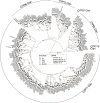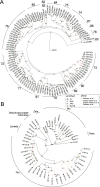Transcriptional response of a target plant to benzoxazinoid and diterpene allelochemicals highlights commonalities in detoxification
- PMID: 35974304
- PMCID: PMC9382751
- DOI: 10.1186/s12870-022-03780-w
Transcriptional response of a target plant to benzoxazinoid and diterpene allelochemicals highlights commonalities in detoxification
Abstract
Background: Plants growing in proximity to other plants are exposed to a variety of metabolites that these neighbors release into the environment. Some species produce allelochemicals to inhibit growth of neighboring plants, which in turn have evolved ways to detoxify these compounds.
Results: In order to understand how the allelochemical-receiving target plants respond to chemically diverse compounds, we performed whole-genome transcriptome analysis of Arabidopsis thaliana exposed to either the benzoxazinoid derivative 2-amino- 3H-phenoxazin-3-one (APO) or momilactone B. These two allelochemicals belong to two very different compound classes, benzoxazinoids and diterpenes, respectively, produced by different Poaceae crop species.
Conclusions: Despite their distinct chemical nature, we observed similar molecular responses of A. thaliana to these allelochemicals. In particular, many of the same or closely related genes belonging to the three-phase detoxification pathway were upregulated in both treatments. Further, we observed an overlap between genes upregulated by allelochemicals and those involved in herbicide detoxification. Our findings highlight the overlap in the transcriptional response of a target plant to natural and synthetic phytotoxic compounds and illustrate how herbicide resistance could arise via pathways involved in plant-plant interaction.
Keywords: 2-amino-3H-phenoxazin-3-one; Allelochemical; Benzoxazinoid; Detoxification; Diterpene; Momilactone B.
© 2022. The Author(s).
Conflict of interest statement
The authors declare no competing interests.
The authors declare no conflict of interest.
Figures




Similar articles
-
Allelopathic substance in rice root exudates: rediscovery of momilactone B as an allelochemical.J Plant Physiol. 2004 Mar;161(3):271-6. doi: 10.1078/0176-1617-01188. J Plant Physiol. 2004. PMID: 15077625
-
Convergent or parallel molecular evolution of momilactone A and B: potent allelochemicals, momilactones have been found only in rice and the moss Hypnum plumaeforme.J Plant Physiol. 2011 Sep 1;168(13):1511-6. doi: 10.1016/j.jplph.2011.03.014. Epub 2011 May 28. J Plant Physiol. 2011. PMID: 21620514 Review.
-
Absorption of momilactone A and B by Arabidopsis thaliana L. and the growth inhibitory effects.J Plant Physiol. 2012 Oct 15;169(15):1471-6. doi: 10.1016/j.jplph.2012.05.022. Epub 2012 Jul 20. J Plant Physiol. 2012. PMID: 22818889
-
Benzoxazinoid allelochemicals in wheat: distribution among foliage, roots, and seeds.J Agric Food Chem. 2006 Feb 22;54(4):1009-15. doi: 10.1021/jf050898h. J Agric Food Chem. 2006. PMID: 16478210
-
The role of momilactones in rice allelopathy.J Chem Ecol. 2013 Feb;39(2):175-85. doi: 10.1007/s10886-013-0236-9. Epub 2013 Feb 6. J Chem Ecol. 2013. PMID: 23385366 Review.
References
-
- Der MH. Einfluss einer Pflanze auf die Andere. Allelopathie Nature. 1938;141:493–493. doi: 10.1038/141493a0. - DOI
-
- Rice E. Allelopathy. 2nd edition. Orlando, Florida: Academic Press; 1983.
-
- Niculaes C, Abramov A, Hannemann L, Frey M. Plant Protection by Benzoxazinoids—Recent Insights into Biosynthesis and Function. Agronomy. 2018;8:143. doi: 10.3390/agronomy8080143. - DOI
-
- Sicker D, Frey M, Schulz M, Gierl A. Role of natural benzoxazinones in the survival strategy of plants. Int Rev Cytol. 2000;198:319–46. - PubMed
MeSH terms
Substances
Grants and funding
LinkOut - more resources
Full Text Sources

